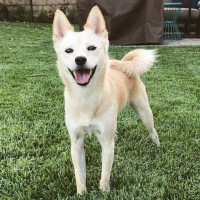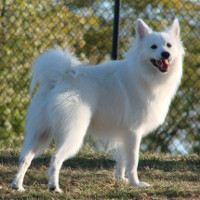Appearance of the Imo-Inu
|
| An Imo-Inu is a compact, medium-sized dog with a firm stance, deep chest and lively expression. They have small, slightly triangular eyes and a tapered muzzle with a scissor bite. Imo-Inus also have a high tail that is sometimes curled if they take on their Spitz heritage. The breed has a double coat, which is dense, straight and of medium length. It comes in solid varieties or multicolored combinations of black, cream, tan, red and cookie with the possibility of white markings on tail and legs. Ears are erect, set high and slightly blunt at the tips. The Imo-Inu also has compact, oval feet with arched toes and deeply padded pads. |
Temperament of the Imo-Inu
|
| Imo-Inus are loving, alert and intelligent dogs. They have the gentle personality of their American Eskimo Dog parent and the courage of their Shiba parent. These dogs become very attached to their families and are known to be obedient pets. In fact, they are considered a highly trainable dog that is easily domesticated. Imo-Inus are also very social. They love to play with their owners and perform tricks for the public. This breed also gets on well with other dogs, although they may chase smaller animals if given the chance. Because Imo-Inus are so social, they are prone to separation anxiety and are not suitable for busy families or owners who travel frequently. At the same time, Imo-Inus can be hesitant around strangers. Early socialization can help shape an open, friendly pet. All in all, the Imo-Inu is a lovable pet that will thrive in a loving, stable home. |
Needs and activities of the Imo-Inu
|
| Imo-Inus have above-average energy levels and love to exercise with their owners. They are quite athletic and should have between 45 and 60 minutes of activity a day. Because they require a good amount of exercise, they are best suited to suburban and rural environments with a yard. However, they can live in urban environments if there is access to grassy areas or off-leash parks. Imo-Inus also have a strong impulse to hunt, so they should always be supervised when outdoors. Note that due to this breed's thick coat, it doesn't do well in hot weather. In addition to exercise, Imo-Inus need a lot of attention, so snuggling at the end of the day is an important part of their routine. |
Maintenance of the Imo-Inu
|
| The Imo-Inu is a low-maintenance pet. However, this breed does shed frequently. shedding is particularly important at the change of season twice a year. Owners can control shedding to some extent, as well as maintaining cleanliness and avoiding tangles with weekly brushing. Imo-Inu only need occasional baths, once every two to three months. However, they do need daily teeth cleaning and one or two nail clippings a month. Owners should regularly clean their Imo-Inu's ears with a damp cloth to prevent wax build-up. Please note that this dog is not hypoallergenic and is not suitable for owners of dogs suffering from allergies. |









 English (United Kingdom)
English (United Kingdom)